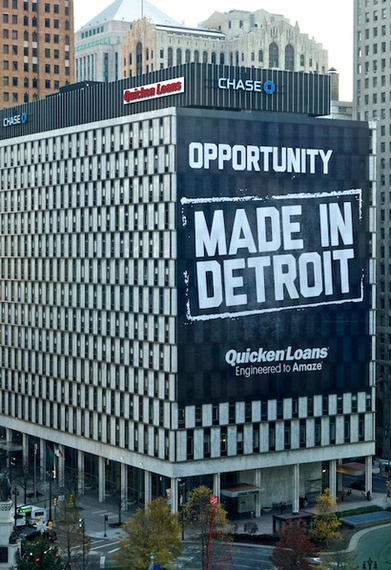Detroit's Revival / The Bell Towers
In Detroit, Michigan, there has been 50 years of continuous population decline. But that decline finally stopped this year, said Detroit mayor Michael Duggan, to rousing applause, at the Congress for New Urbanism, which met this year in this resurgent rust-belt city. In the 1950s, the city topped 1.8 million people. Last year, it slid to a new low of 677,000 but is now holding steady. A model of the car-centric city, Detroit tops 142 square miles; it can fit San Francisco, Boston, and Manhattan within its boundaries. Some 400,000 single family homes had been built within the city limits, because "every car factory worker could afford one." Now thousands of vacant buildings and lots litter neighborhoods.
The decline of manufacturing coupled with "racist policies" eventually inflicted their toll. Banks red-lined whole swaths of the city, going as far as even building a four-foot wall in one community at 8 Mile and Wyoming to ensure "African Americans would not be allowed to buy homes past there." After years of injustice, what followed were destructive riots that tore the city apart and further accelerated white flight to the suburbs. By the end of the 60s, "us versus them politics had taken over."
Today, Mayor Duggan, the first white man elected mayor of the majority-African American city since the mid-70s, with 90 percent of the vote, said the city is "open to everyone, black or white, gay or straight." The city is moving beyond the divisions of the past with a new agenda that focuses on improving services for everyone and concentrating development in order to create an "authentic Detroit" urban experience.
Duggan said one of the first things he fixed was all the streetlights. Instead of burnt out bulbs, all of Detroit's streets are now lit at night. He also ensured that ambulances, which used to arrive up to an hour after a resident called 911, now make it in 8 minutes, which is less than the required average time.
Given the wealthy suburbs of Detroit still offer a great draw, "we can't compete with them." Instead, Detroit must offer a new urban experience by leveraging "the tight urban grids" and building in more density. "We want to create more 20-minute neighborhoods" using light-rail, transit-oriented development, and the riverfront. Duggan recruited Maurice Cox, who was planning director for New Orleans and Alexandria, Virginia, to lead these efforts. With Cox, Duggan wants to create an "authentic Detroit experience" that can pull people in from the suburbs and elsewhere.
Duggan also wants to spread the benefits beyond downtown. "We have an enormous responsibility to make sure every neighborhood has a future."
Carol Coletta, senior fellow with the Kresge Foundation, which has been committed to supporting the city's resurgence for years, said that as Detroit rebounds, there are already concerns about gentrification. But she argued that "there are a lot of people in Detroit who wouldn't mind a little gentrification if it results in new houses and shops."
Coletta pointed to a number of studies, arguing that communities actually must gentrify, given the alternative is often a "slow, often-unnoticed deterioration." Once that decline sets in, it's nearly impossible for the community to rebound. "Only 105 communities out of the 1,100 deemed high poverty in 1970 have rebounded over the past 40 years." And today, there are now 3,000 high-poverty communities, and the number of poor have grown from 2 million to 4 million. "Over the past 40 years, we've tripled the number of poor communities and doubled the number of poor, which is an abysmal record."
To ensure "more poor communities don't displace poor people with their lack of opportunities," we need to use "government incentives, foundation funds, and market forces" to increase investment without displacement. "Mixed-income communities are the goal because they increase life outcomes."
However, moving the poor to wealthier communities in order to create mixed-income places is "slow and expensive." Instead, she called for a special effort to "ensure low-income neighborhoods benefit new people coming in and to create incentives to get the wealthy to move to poor areas." With equitable gentrification, "we can accelerate the benefits and share them." Coletta also called for dramatically increasing the supply of affordable housing in these gentrifying neighborhoods, beyond what Portland, Oregon, and New York City, have accomplished, and called an end to the "just green enough" movement, which calls for adding new parks and other amenities to poor areas, but not any that are so nice they will raise property values.
"The 'just green enough' idea is craziness born of real frustration. We need more quality neighborhoods, not less. We need new parks, libraries, trails, gardens, and re-imagined community infrastructure in places that offer good options at all price points. Equity is not about being opposed to thriving, appealing cities. That's actually central to equity."

